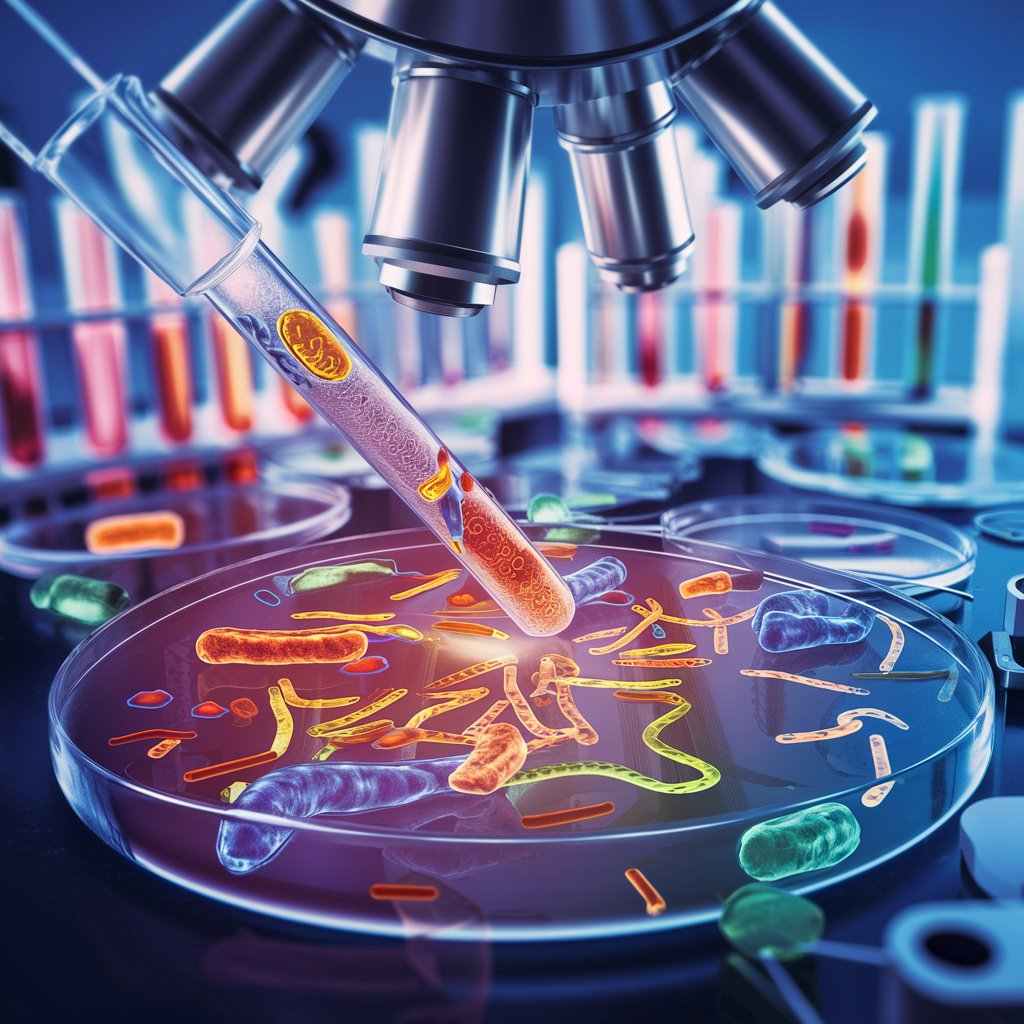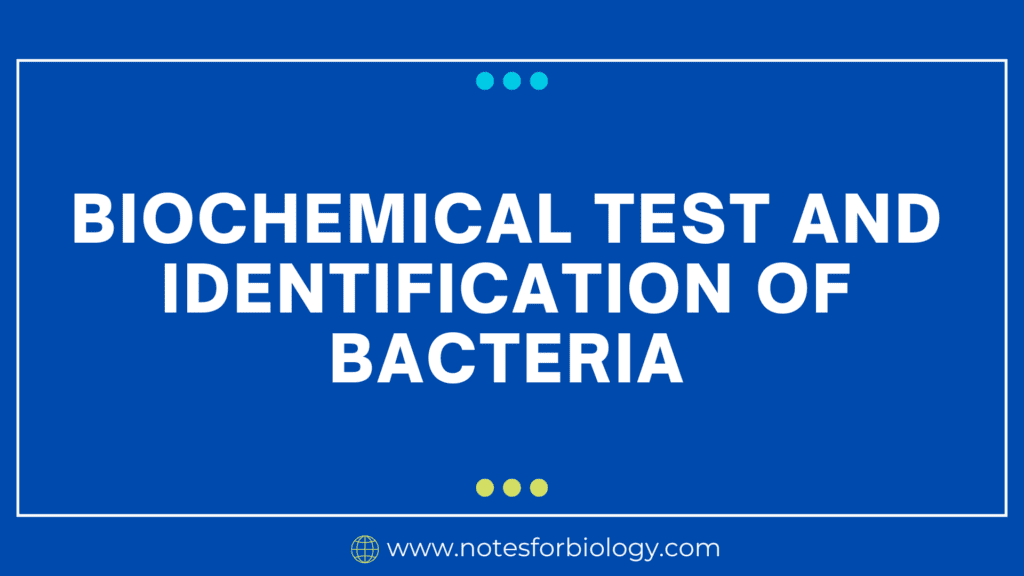Biochemical Test: In microbiology, Biochemical Test are crucial instruments for classifying bacteria according to their metabolic traits and biochemical activity. I’ll go into great depth about each test’s premise, methodology, and interpretation below.

Table of Contents
Biochemical Test interpretation below
1. Gram Staining
Principle: Differentiates bacteria based on the chemical and physical properties of their cell walls.
Procedure
On a glass slide, prepare a bacterial stain and heat-fix it.
Use crystal violet stain for a minute.
After one minute of iodine solution addition, rinse with water.
After rinsing with water, decolorize with acetone or 95% ethanol for ten to thirty seconds.
After rinsing with water, spend 30 seconds counterstaining with safranin.
After rinsing, pat dry and examine under a microscope.
Interpretation
Gram-positive: Appear purple and maintain the crystal violet-iodine combination.
Gram-negative: Due to the safranin counterstain, they look pink or red and lose the crystal violet-iodine complex after decolorization.
2. Catalase Test
Concept: Identifies the existence of the catalase enzyme, which converts hydrogen peroxide into oxygen and water.
On a clean glass slide, a small amount of bacterial colony should be added.
Add a drop of 3% hydrogen peroxide.
Interpretation
Positive: Rapid bubbling indicates the presence of catalase, which includes some species of Staphylococcus.
(Streptococcus spp.) Negative No bubbles form
3. Oxidase Test
Principle: Identifies bacteria that produce cytochrome c oxidase, which participates in the electron transport chain.
Procedure:
Use an oxidase reagent (tetramethyl-p-phenylenediamine) on a piece of filter paper or directly on a bacterial colony.
Interpretation
- Positive: Dark purple color within 10-30 seconds indicates oxidase activity (e.g., Pseudomonas spp.).
- Negative: No color change (e.g., Escherichia coli).
4. Coagulase Test
Principle: Detects the production of coagulase, an enzyme that causes blood plasma to clot.
Procedure
In a slide test or tube test, combine a little quantity of bacterial colony with rabbit plasma.
Watch for the development of clots. Interpretation
Positive: The development of clots signifies the presence of coagulase (Staph aureus, for example).
Negative: No blood clot developed.
5. Indole Test
Principle: Determines the ability of bacteria to produce indole from tryptophan using the enzyme tryptophanase.
Procedure
Tryptone broth should be inoculated with bacteria, then incubated for 24-48 hours at 35–37°C.
To the culture, add Kovac’s reagent. Interpretation
Positive: The synthesis of indole (e.g., Escherichia coli) is shown by a red ring at the top of the medium.
Negative: There isn’t a red ring (like Enterobacter species).
6. Methyl Red (MR) and Voges-Proskauer (VP) Tests
Principle: Distinguishes butanediol fermenters from mixed acid fermenters.
Method:
Add the test organism to MR-VP broth and let it incubate.
After the incubation period, divide the culture into two halves.
Add a few drops of methyl red indicator for the MR test.
To conduct the VP test, combine 40% KOH and α-naphthol.
Interpretation
MR Positive: Stable acid production (e.g., Escherichia coli) is indicated by the red hue.
MR Negative: The hue yellow.
VP Positive: The synthesis of acetoin (e.g., Enterobacter spp.) is indicated by the red hue within 30 minutes.
VP Negative: No change in hue.
7. Citrate Utilization Test
Principle: Tests the ability of bacteria to use citrate as the sole carbon source.
Procedure
Inoculate Simmon’s citrate agar slant with the test organism.
Incubate at 35-37°C for 24-48 hours.
Interpretation
- Positive: Blue color change indicates citrate utilization (e.g., Enterobacter spp.).
- Negative: No color change; remains green (e.g., Escherichia coli).
8. Urease Test
Principle: Detects the enzyme urease, which hydrolyzes urea to ammonia and carbon dioxide.
Procedure:
Inoculate urea broth or urea agar slant with the test organism.
Incubate at 35-37°C for 24-48 hours.
Interpretation
- Positive: Pink color indicates urease activity (e.g., Proteus spp.).
- Negative: No color change.
9. Triple Sugar Iron (TSI) Agar Test
Principle: Differentiates bacteria based on glucose, lactose, sucrose fermentation, and hydrogen sulfide (H2S) production.
Procedure
Inoculate TSI agar slant by stabbing the butt and streaking the slant.
Incubate at 35-37°C for 18-24 hours.
Interpretation
- Yellow slant/yellow butt: Ferments lactose and/or sucrose.
- Red slant/yellow butt: Ferments glucose only.
- Black precipitate: H2S production.
- Gas production: Bubbles or cracks in agar.
10. Nitrate Reduction Test
Principle: Determines the ability of bacteria to reduce nitrate (NO3) to nitrite (NO2) or nitrogen gas (N2).
Procedure
Inoculate nitrate broth with the test organism and incubate at 35-37°C for 24-48 hours.
Add sulfanilic acid and α-naphthylamine to the broth.
Interpretation
- Positive: Red color after adding reagents indicates nitrite production.
- Negative: No color change; further test with zinc dust:
- Red after zinc: No reduction (true negative).
- No color after zinc: Reduction to nitrogen gas (positive).
11. Mannitol Salt Agar (MSA) Test
Principle: Selects for Staphylococcus species and differentiates based on mannitol fermentation.
Procedure
Streak the organism on MSA plate.
Incubate at 35-37°C for 24-48 hours.
Interpretation
- Yellow colonies with yellow surrounding medium: Mannitol fermentation (e.g., Staphylococcus aureus).
- Pink/red colonies: No mannitol fermentation (e.g., Staphylococcus epidermidis).
12. MacConkey Agar Test
Principle: Selects for Gram-negative bacteria and differentiates based on lactose fermentation.
Procedure
Spread the bacterium on an agar MacConkey plate.
Incubate for 24 to 48 hours at 35 to 37°C.
Interpretation
Red or pink colonies: Lactose fermentation (Escherichia coli, for example).
Colonies without color: No lactose fermentation (Salmonella spp., for example).
Identification of Bacteria
Regular morphological and biochemical tests are used to identify bacteria; specific tests like serotyping and antibiotic inhibition patterns are added as needed. Through the use of genetic sequences, species may occasionally be recognized directly from clinical specimens thanks to more advanced molecular methods.
Frequently Asked Question
1. What is a Biochemical Test used to determine in microbiology?
A biochemical test is used to assess a microbe’s capacity to carry out a certain enzymatic activity. DNA sequences’ nucleic acid-base makeup.
2. What Biochemical Test are used to identify gram positive bacteria?
Biochemical tests such as the urease, oxidase, indole, sulfur, and methyl red/voges-proskauer tests are used to identify Gram negative bacteria, whereas the catalase, coagulase, starch hydrolysis, and nitrate tests are used to identify Gram positive bacteria.
3. What is the Biochemical Test method of identifying bacteria?
A scientist applies hydrogen peroxide to a bacterial smear on a microscope slide in order to determine if the germs have the catalase enzyme. The mixture bubbles as the hydrogen peroxide breaks down into oxygen and water if the bacteria have catalase.
4. What is being detected in biochemical testing?
testing for hydrogen sulfide generation (Figure 2.18(D)), citric acid utilization (Figure 2.18(C)), methyl red (Figure 2.18(B)), and carbohydrate fermentation (Figure 2.18(A)) are examples of biochemical testing.
5. What are biochemical tests for diseases?
Biochemical test evaluates the levels of lipoproteins (fats) in the blood: Provides indicators such as levels of total cholesterol in the blood, LDL-C, HDL-C and triglycerides.
Related Article

